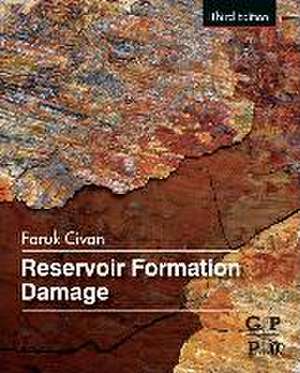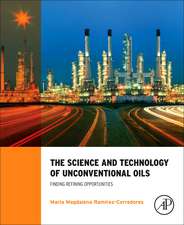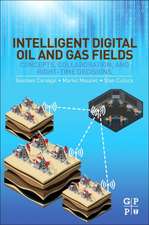Reservoir Formation Damage
Autor Faruk Civanen Limba Engleză Hardback – 23 sep 2015
The text helps readers better understand the processes causing formation damage and the factors that can lead to reduced flow efficiency in near-wellbore formation during the various phases of oil and gas production.
The third edition in the series provides the most all-encompassing volume to date, adding new material on conformance and water control, hydraulic fracturing, special procedures for unconventional reservoirs, field applications design, and cost assessment for damage control measures and strategies.
- Understand relevant formation damage processes by laboratory and field testing
- Develop theories and mathematical expressions for description of the fundamental mechanisms and processes
- Predict and simulate the consequences and scenarios of the various types of formation damage processes encountered in petroleum reservoirs
- Develop methodologies and optimal strategies for formation damage control and remediation
| Toate formatele și edițiile | Preț | Express |
|---|---|---|
| Hardback (2) | 945.17 lei 36-50 zile | |
| ELSEVIER SCIENCE – 23 sep 2015 | 945.17 lei 36-50 zile | |
| ELSEVIER SCIENCE – 28 mar 2023 | 1490.59 lei 43-57 zile |
Preț: 945.17 lei
Preț vechi: 1236.23 lei
-24% Nou
Puncte Express: 1418
Preț estimativ în valută:
180.88€ • 187.69$ • 151.18£
180.88€ • 187.69$ • 151.18£
Carte tipărită la comandă
Livrare economică 10-24 martie
Preluare comenzi: 021 569.72.76
Specificații
ISBN-13: 9780128018989
ISBN-10: 0128018984
Pagini: 1042
Ilustrații: Approx. 250 illustrations
Dimensiuni: 191 x 235 x 51 mm
Greutate: 2.31 kg
Ediția:Revised
Editura: ELSEVIER SCIENCE
ISBN-10: 0128018984
Pagini: 1042
Ilustrații: Approx. 250 illustrations
Dimensiuni: 191 x 235 x 51 mm
Greutate: 2.31 kg
Ediția:Revised
Editura: ELSEVIER SCIENCE
Cuprins
1. Overview of Formation Damage
PART I - Characterization of Reservoir Rock for Formation Damage—Reservoir Formations, Description and Characterization, Damage Potential, and Petrographics
2. Description and Characterization of Oil and Gas Reservoirs for Formation Damage Potential
3. Petrographical Characteristics of Petroleum-Bearing Formations
PART II - Characterization of the Porous Media Processes for Formation Damage—Porosity and Permeability, Mineralogy Sensitivity, Petrophysics, Rate Processes, Rock-Fluid-Particle Interactions, and Accountability of Phases and Species
4. Alteration of the Porosity and Permeability of Geological Formations- Basic and Advanced Relationships
5. Mineral Sensitivity of Petroleum–Bearing Formations
6. Petrophysical Alterations– Fluid Disposition, Distribution, and Entrapment, Flow Functions, and Petrophysical Parameters of Geological Formations
7. Phase Equilibria, Solubility, and Precipitation in Porous Media
8. Particulate Processes in Porous Media
9. Multi-Phase and Multi-Species Transport in Porous Media
PART III - Formation Damage by Particulate Processes—Single- and Multi-Phase Fines Migration, Clay Swelling, Filtrate and Particulate Invasion, Filter Cake, Stress Sensitivity, and Sanding
10. Single-Phase Formation Damage by Fines Migration and Clay Swelling
11. Multi-Phase Formation Damage by Fines Migration
12. Cake Filtration: Mechanism, Parameters and Modeling
13. Injectivity of the Waterflooding Wells
14. Drilling-Induced Near-Wellbore Formation Damage: Drilling Mud Filtrate and Solids Invasion and Mudcake Formation
15. Reservoir Stress-Induced Formation Damage: Formation Compaction, Subsidence, Sanding Tendency, Sand Migration, Prediction and Control, and Gravel-Pack Damage
PART IV - Formation Damage by Inorganic and Organic Precipitation Processes—Chemical Reactions, Saturation Phenomena, Dissolution, Precipitation, and Deposition
16. Inorganic Scaling and Geochemical Formation Damage
17. Formation Damage by Organic Deposition
PART V - Laboratory Assessment of the Formation Damage Potential—Instrumental Techniques, Testing, Analysis, and Interpretation
18. Instrumental and Laboratory Techniques for Characterization of Reservoir Rock
19. Laboratory Evaluation of Formation Damage
PART VI - Field Diagnosis and Mitigation of Formation Damage—Measurement, Assessment, Control, and Remediation
20. Field Diagnosis and Measurement of Formation Damage
21. Determination of Formation- and Pseudo-Damage from Well Performance- Identification, Characterization, and Evaluation
22. Formation Damage Control and Remediation- Fundamentals
23. Reservoir Formation Damage Abatement- Guidelines, Methodology, Preventive Maintenance, and Remediation Treatments
PART VII - Modeling and Simulation of Formation Damage- Prediction of the Near-Wellbore Formation Damage and the Combined Effects of Fluid, Completion, and Formation Damages on Well Performance by Various Modeling and Simulation Approaches and Examples
24. Near-Wellbore Formation Damage by Inorganic and Organic Precipitates Deposition
25. Interactions and Coupling of Reservoir Fluid, Completion, and Formation Damages
26. Formation Damage Simulator Development
27. Model Assisted Analysis and Interpretation of Laboratory and Field Tests
PART I - Characterization of Reservoir Rock for Formation Damage—Reservoir Formations, Description and Characterization, Damage Potential, and Petrographics
2. Description and Characterization of Oil and Gas Reservoirs for Formation Damage Potential
3. Petrographical Characteristics of Petroleum-Bearing Formations
PART II - Characterization of the Porous Media Processes for Formation Damage—Porosity and Permeability, Mineralogy Sensitivity, Petrophysics, Rate Processes, Rock-Fluid-Particle Interactions, and Accountability of Phases and Species
4. Alteration of the Porosity and Permeability of Geological Formations- Basic and Advanced Relationships
5. Mineral Sensitivity of Petroleum–Bearing Formations
6. Petrophysical Alterations– Fluid Disposition, Distribution, and Entrapment, Flow Functions, and Petrophysical Parameters of Geological Formations
7. Phase Equilibria, Solubility, and Precipitation in Porous Media
8. Particulate Processes in Porous Media
9. Multi-Phase and Multi-Species Transport in Porous Media
PART III - Formation Damage by Particulate Processes—Single- and Multi-Phase Fines Migration, Clay Swelling, Filtrate and Particulate Invasion, Filter Cake, Stress Sensitivity, and Sanding
10. Single-Phase Formation Damage by Fines Migration and Clay Swelling
11. Multi-Phase Formation Damage by Fines Migration
12. Cake Filtration: Mechanism, Parameters and Modeling
13. Injectivity of the Waterflooding Wells
14. Drilling-Induced Near-Wellbore Formation Damage: Drilling Mud Filtrate and Solids Invasion and Mudcake Formation
15. Reservoir Stress-Induced Formation Damage: Formation Compaction, Subsidence, Sanding Tendency, Sand Migration, Prediction and Control, and Gravel-Pack Damage
PART IV - Formation Damage by Inorganic and Organic Precipitation Processes—Chemical Reactions, Saturation Phenomena, Dissolution, Precipitation, and Deposition
16. Inorganic Scaling and Geochemical Formation Damage
17. Formation Damage by Organic Deposition
PART V - Laboratory Assessment of the Formation Damage Potential—Instrumental Techniques, Testing, Analysis, and Interpretation
18. Instrumental and Laboratory Techniques for Characterization of Reservoir Rock
19. Laboratory Evaluation of Formation Damage
PART VI - Field Diagnosis and Mitigation of Formation Damage—Measurement, Assessment, Control, and Remediation
20. Field Diagnosis and Measurement of Formation Damage
21. Determination of Formation- and Pseudo-Damage from Well Performance- Identification, Characterization, and Evaluation
22. Formation Damage Control and Remediation- Fundamentals
23. Reservoir Formation Damage Abatement- Guidelines, Methodology, Preventive Maintenance, and Remediation Treatments
PART VII - Modeling and Simulation of Formation Damage- Prediction of the Near-Wellbore Formation Damage and the Combined Effects of Fluid, Completion, and Formation Damages on Well Performance by Various Modeling and Simulation Approaches and Examples
24. Near-Wellbore Formation Damage by Inorganic and Organic Precipitates Deposition
25. Interactions and Coupling of Reservoir Fluid, Completion, and Formation Damages
26. Formation Damage Simulator Development
27. Model Assisted Analysis and Interpretation of Laboratory and Field Tests























